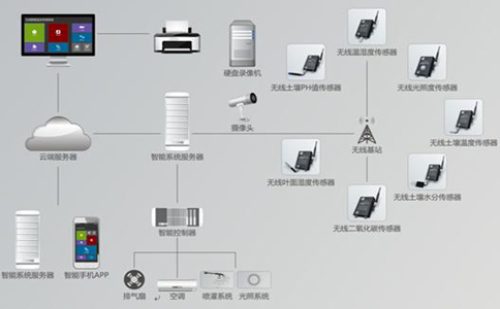Guidance: The temperature and humidity monitoring system automatically controls the operation of various devices according to the user-defined temperature range and control interval and duration. The system provides a setting interface. The administrator can set upper and lower limit values ​​for parameters such as temperature, light, moisture, and salinity. The temperature and humidity control system detects whether the indoor parameters are within the set threshold in real time and controls the equipment at any time to maintain the stability of the indoor environment.

The main components of smart agriculture are agricultural big data platforms and intelligent monitoring systems. Big data is the main basis for smart agricultural planting. The intelligent monitoring system for temperature and humidity is the guarantee for greenhouse planting environment.
1. In the temperature detection mode, the preset upper and lower temperature limits determine the fluctuation of the indoor temperature, and also determine the opening mode of the device. The system has previously performed a segmentation process. In different temperature gradient modes, the number of actions of the controlled device is different. For example, the group-managed axial wind winder is preset in several temperature gradient levels, and when the temperature changes by one gradient level, the number of blower fans will be different. In addition, the control system will optimize the analysis based on the meteorological parameters returned by the outdoor weather station, and fully utilize the outdoor weather to supplement or adjust the indoor temperature demand. Minimize frequent opening and closing of equipment, increase equipment life, save energy consumption, and reduce operating costs. While the control system regulates the indoor temperature, the side windows, water curtains, and internal circulation fans are the control system variables. According to the set logic analysis library and various parameters of the real-time changes in the control system from the main decision which devices open and which devices are closed.
2. CO2 replenishment control is divided into two options: timing replenishment and threshold replenishment. In the timing mode, only the timing interval and replenishment duration need to be set, and automatic replenishment can be performed in all time periods of the whole day. At the same time, the CO2 collection sensor connected to the system can collect the amount of CO2 remaining, when CO2 reaches the alarm preset After the value is sent, an alarm request will be submitted prompting the administrator to replace or supplement the air supply. In the threshold replenishment control mode, the system monitors the indoor CO2 concentration in real time. Once the CO2 concentration reaches the lower limit, the system automatically controls the opening and closing of the solenoid valve according to the user-defined replenishing time and replenishment intervals. .
3. Water and fertilizer intelligent compensation model According to the real-time data returned by the moisture sensor, salt, and PH detector beforehand, and compared with the set reference value, comprehensive supply of nutrients and moisture is performed within a predefined time period.
4. The fill light intensity control section uses the sun illuminance of the outdoor weather station and the indoor light sensor as two important reference points. Due to the lag and randomness of the light, the system only pre-sets the threshold value of the illumination starting intensity. When the indoor illumination is insufficient, the system will converge the shade net. If the set value is not reached, the fill light is turned on. The shade net is deployed once the indoor and outdoor lighting thresholds exceed a preset value.
5. The control center can realize the self-start function of power failure. Once the system is stopped due to the power outage caused by the power supply problem during the operation period, the system will automatically enter the control state after the abnormality of the power supply is removed and the power is turned on, according to the indoor parameters. The control method is automatically adjusted again to adapt to the control requirements of the controlled environment.
6. The control system has environmental data storage function. All-day data cycle is stored in the SD card inserted into the software system or hardware. The administrator only needs to remove the built-in SD card and connect it to the PC to read all the historical data. Take out and complete the collection of adult data. The recorded data and data recording frequency can be set as needed.
7. Supporting a backup power supply system, when the power supply is unstable, power-off maintenance or power supply failure, reset the control system in time, save the working status, maintain the minimum operating voltage of the main control core, and perform fault alarm through the SMS platform. The configured backup power supply will fully charge the battery of the backup power supply in normal power supply mode in case of emergency. The back-up power supply can also be connected to a solar panel, which is particularly suitable for low-power applications where only recording is required.
8. Reserve a plurality of control interface, and in the later period when it is necessary to replenish the device, add the device according to the system protocol, so as not to affect the working condition of the previous system.
Maskking(Shenzhen) Technology CO., LTD , https://www.szelectroniccigarette.com